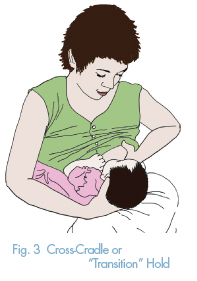More mother-guided breastfeeding positions to try:
|
Cradling
Let’s start with your left breast. Cradle your baby in your left arm, your baby’s head resting on your left forearm (not your hand) with his feet angled down to your right. Hold him securely behind his back and shoulders, rather than his bottom. (No need to reach for a “breastfeeding pillow.” Pillows are flat, and babies feed better at an angle.) • Hold your baby on his side with his whole body facing yours, underneath your breasts. His knees and feet will be pulled in close to your body, below your breasts and angled down. His hip may even rest on your thigh. • Let his head tilt slightly back so he can feel your breast with his cheek or chin, his nose right near your nipple. • Bring your baby toward your breast with the arm his head is resting on. • Hold your breast if you need to. Be sure your fingers are well away from your baby’s chin. He needs to get a good mouthful of breast into his mouth, and he can do that more easily if you don’t try to center your nipple in his mouth. Instead, your nipple can just sneak in under his upper lip as he takes a mouthful of breast. Using Your Opposite Arm • If you’re nursing with your left breast, use your right arm to hold your baby across your body, facing you, underneath your breasts. Your arm goes behind his back, with your fingers cradling his neck. • Bring your baby’s head to the level of your nipple. Lean back slightly so your body helps take your baby’s weight. If you use pillows, put them along your side to support your arms (not your baby). Regular sofa or bed pillows give you more flexibility in arranging them – “breastfeeding pillows” may put the baby too high or too far away from you. • If you’ll be nursing with your left breast, your left hand supports that breast with your thumb on one side and your fingers on the other side. Many mothers keep their fingers on their breastbone to keep them well out of the baby’s way. • The palm of your hand, positioned between his shoulder blades, will support him. Gently place your thumb and index finger behind each ear. Your baby’s neck rests in the web between them. • Lift your baby so his nose is near your nipple, his legs angled down, maybe even with his leg or hip resting on your thigh. This will help him tilt his head back for a deeper latch. If you need to prompt him to open his mouth, touch your nipple to the space between his nose and upper lip. When he opens his mouth wide, bring him to your breast with gentle pressure from the palm of your hand between his shoulder blades. • Remember that he needs to take a mouthful of breast, with your nipple just sneaking in under his upper lip. • Once your baby is taking deep, strong sucks, slowly relax the hand holding your breast, use your forearm to pull your baby’s body in close and smoothly switch arms to cradle your baby so you can sit more comfortably while nursing. |
|
Side-Holding
• Tuck your baby’s body along your side, under your arm, so that his head is looking toward your breast. • Support your breast with the other hand. If you’re nursing on your left breast, your right hand will be supporting the breast with the thumb above and the fingers below and well back from your nipple. • Support your baby’s neck (not head) with your palm on your baby’s upper back, thumb behind one ear and index and other fingers behind the other ear. • Rest your baby’s upper back along your forearm with his body on a pillow near your elbow and his hips against the back of the chair, sofa, or against the wall. His feet can touch whatever surface is behind you. • Your baby’s body should be supported so that he is high enough and his body is positioned far enough back so that your nipple is just above his mouth. He shouldn’t have to bend his neck forward to latch – his head, neck, and hips should be in a straight line, with his legs bent. |
|
Lying Down
• Practice during the day, when you’re awake! Then it will be easier when you’re sleepy. • Let’s suppose you’re lying on your left side, facing your baby. Your baby faces you, too. Use pillows under your head, behind your back, even between your knees – whatever makes you comfortable. Lift your breast and set it back down on the bed to “get the kinks out.” Bring your baby’s feet close to your body, and line him up so your nipple is near his eye. (It sounds weird, but try it!) • Snuggle your baby closer, using your right hand on your baby’s back. Avoid pressing on the back of his head. His head will tip back so that he can latch. • You may need to use your right hand to help him at first, with your left hand supporting his back. Switch hands once he’s nursing, for a comfortable position. • You can also begin nursing by sitting up, then skootch down. |





